Yoga on Kilimanjaro is very much doable and perhaps one of the most famous people to do Yoga specifically on Kilimanjaro is Wim Hof (the Dutch record holder of 26 Guinness World Records). Other than on Kilimanjaro, you can perform Yoga sessions even while on safari or on Zanzibar beach holidays. Pranayama and respiration workshops help students to deepen the physical process and generally create a test of how they respond to these techniques. Integration, which means integrating the techniques of pranayama, asana, and meditation, is critical in the preparation for the summit. If there is a day when the summit is derailed by atmospheric conditions, we work as an even closer team, helping us recover in the now adverse situation and into the next steps.
We will have experienced mountain guides and professional porters, and I, a certified yoga teacher, will be with you every step of the way. Each [pre-summit] day, our job is to see it in you. Peak asana pose models are the key, showing how to save energy and time, then using natural acclimatization training to maintain comfort.
Many people come to Kilimanjaro with fitness steeled by practising some form of yoga. Whether for flexibility, physical endurance or mental – the mountain and yoga are almost hand in glove. This is a collection of information about practising yoga on Mount Kilimanjaro.
Preparing for Yoga on Mount Kilimanjaro
You need to practice yoga. I can’t stress this enough, practicing yoga on Kilimanjaro is a lot more than just posing for Instagram. You cannot rely solely on the hype of a top-down legless pincha or a press-handstand to carry your glutes through this. Tweeny boppers may be able to accomplish tremendous physical performances without caring about why, but you and I know that as an adult, aimlessly throwing parts of your body up in the air, towards an approximately theoretical form of a pose, isn’t yoga. There is less elongation of the calf muscle in Tadasana and Urdhva Hastasana. Meditating, chanting and practicing the first three sections of the Ashtanga primary series is far more appropriate for preparing for a 7 (or more) day trek into the Masai prairies at 4000 meters and up!
View this post on Instagram
Be honest about your fitness level! If you are already practicing yoga, you are already better prepared than many Kili climbers. If you are a mountain dweller and inhabit the 7th floor like me, if you are a marathoner, cross-fitter or ballet dancer, rest assured that your body is getting there. On the other hand, this expedition is no place for vanity, ego or recalcitrant victims of “not invented here” syndrome. There is not one single truth when it comes to getting fit, we all need to work differently with our strengths, weaknesses, our past injuries, period of life, motivations etc.
Feeling the call to yoga on Kilimanjaro? You are ready to set foot on the highest peak of Africa! Before you go to Tanzania to undertake this great adventure, you need to get ready. With an altitude of 5895m, Kilimanjaro cannot be climbed lightly. Altitude sickness is very real and can be fatal – much more common than it is often believed. Here are some things to consider before you leave.
 Physical preparation
Physical preparation
While at sea level, shortly before your departure, go for your last walks with an altitude mask to improve your breathing and your cardio system. The mask has to be set at a level percentage of oxygen set on 5 or 6, as well as at an elevation percentage of 21 or 26 degrees. This will give your leg muscles the best boost and create red blood cells to optimize your oxygen intake. A mask for the gym does not have the same abilities as an outdoor mask. Also, take with you elastic bands that include exercises which are part of martial arts, karate and running. At Shira 2 camp, where the terrain is flat and without obstacles, you use the elastics for 20 minutes to develop your running muscles by respecting the position of the body: elbows bent at 90 degrees and parallel to the ground while controlling your abdominal, lumbar, psoas, quadriceps and muscles of the foot.
When you are considering doing yoga at such a high altitude, some physical preparation is necessary. In preparation for your trek, you should plan to walk at a brisk pace through your local park for a minimum of 30 minutes at least 4-5 times a week. Your knees and ankles need to be well prepared for the repeated descent on your trek. The long walks you schedule in the next couple of weeks will allow time for them to repair, and it will prepare your body for the descent. If you are walking indoors, use the stair stepper. If you do not have access to either option, you can walk on a treadmill with the inclination set as high as possible. What will be important during your climb will not be your running capacity, but how your muscles respond to the continuous effort of walking at a fast pace up a steady inclined walk.
 Mental preparation
Mental preparation
Finally, last but not least: do not fall into the trap of setting the intention of reaching the top of Kilimanjaro or wherever journey. It would build up mental barriers and an obsession of dominating the mountain. Rather, set the intention of blessings, and even better yet, remain empty of need.
By acknowledging that we are all one, essentially the same, made of the same stuff, Ujaama inspired the concept of collective Sankalpa. This meditation is a great way to get closer to that feeling. Still your thoughts, still your breath and keep the thought of the collective prayer in your body. Find a comfortable seated position, on the floor, on your bed, or in a chair. Your hands rest gently on your knees, your arms lengthen down and away from your shoulders and your abdomen softens. Quiet your eyes, quiet your muscles, and invite yourself to remain here as you listen to these words. Please take a series of long smooth breaths. For each breath, allow the exhales to lengthen and adjust your body so that you are sitting up as tall as you can. With a soft breath out, relax your eyes and your jaw, your shoulders and your belly. Keep breathing so that you gently expand your inhalations while allowing your exhalations to remain releasing. (Objective: success with at will Sushumna breath).
Meditation is the best tool to connect with yourself and clear your mind. The act of meditating can bring so much inner healing energy to our system. Moreover, it’s also a great way to develop that mental tool many times called “mindfulness”. There is no specific rule in meditating. You can do it nearly anywhere, and for any time you’d like. We recommend the “alert passive” meditation as a good choice. Here is another rule of thumb: Life force energy gets enhanced by quality meditation followed by Pranayama. So before you begin your month by month preparation, work on your meditation, Pranayama, and yoga skills.
 Yoga Practices on Mount Kilimanjaro
Yoga Practices on Mount Kilimanjaro
Yin Yoga – It has become the complementary aspect of physical activities and is a good way to live a life in peace. Yin Yoga works on the principle of yin and yang, is a slower and more passive version than other yoga classes and is passive in this sense. However, staying in one of these poses for a long period of 3 to 5 minutes can not only improve the flexibility and strength of the body’s postural muscles, but also gives you the necessary time to sit with the mental and physical sensations of a given moment. At this level, this type of practice is interrelated with Buddhist principles in its aspect of mindfulness and acceptance of the moment.
Yoga before sleeping – You might be confined to your tent after 6pm as it gets dark soon. You will have a very good rest within a sleeping bag on a good quality mattress in your tent. As it gets dark after 6pm, you have time to stretch and find your peace. The best way to relax is by doing Yin Yoga, about 5 times per week if you will be going up the mountain. Then rest days, Viparita Karani is the best treatment for you. It’s good to keep that pose for at least 15 min every day at the amount of 5 times per week to feel the benefits. Also, you can do Restorative Yoga, but don’t push yourself in these poses, it is important to feel comfortable. So what is Yin Yoga and what is the importance of Viparita Karani for the rest days and the goal of conceiving this type of e-book?
 Breathing exercises
Breathing exercises
Three Types of Pranayama: There are three major types of pranayama: kumbhaka (breath retention), rechaka (exhalation), and puraka (inhalation), all of which can be performed at a normal, slow, or fast pace. Advocates of pranayama exercises make some pretty convincing claims about their benefits such as reduction of stress, better sleep, losing weight, and even plumping up your lips. If you have an established pranayama practice, then by all means, it would be therapeutic at altitude to bring you some yoga preset that you are comfortable with. If you’re new to pranayama, my advice would be to wait until after the Kilimanjaro climb to start practicing the vast pranayama techniques with a qualified teacher.
In addition to their physical benefits, the various types of pranayama, or yogic breathing, also help to build concentration for meditation. Conscious, mindful breathing focuses attention on both the breath and relaxation. This creates a bridge between the body and the mind and can help improve general health and emotional well-being. Yogic breathing exercises train you to breathe using your diaphragm (the muscular wall located at the base of the rib cage). For this reason, yogis usually breathe through their nose, which can carry the breath more efficiently to the diaphragm. Most of the pranayama exercises found in modern-day asana classes stem from the Hatha Yoga Pradipika.
Standing poses
Warrior II. Start standing at the heart of your stance with feet under the hips, turn the right toes to face the right and the left toes slightly in so that the rear foot is at about 75 degrees. Inhale to stretch your arms straight out over the legs. It’s simply a poor pose to practice in the middle of a trek because it’s rather difficult concerning balancing, and can sometimes lose center. Maintain the right upper shin perpendicular to the ground with the 90-degree aspect of the knee. If you concentrate behind you, you can do it while trekking. The aim is to have your left hip (front hip) tucked under the right hip (behind hip) to square the hips and stretch the lower back. For a few breaths, take a deep breath in the pose, make sure to reach up through the arms while retaining the bend in the front knee and deeply in the pose. When it’s time, return to standing straight ahead at Bhairav Ghufa, then repeat over the opposite leg.
Standing poses. Most standing poses practiced in a regular yoga class can be done while trekking. The best standing pose to practice on the trek is the Warrior II pose. This pose opens the shoulders, chest, abdomen, and hips. The act of pressing the feet down and reaching up with the arms also stretches and strengthens the legs and ankles.
Balancing poses
You can use the roots of trees or shrubs, rocks, sometimes boulders, and even your tent’s support to hold. Always try to face the directions in respect to the sun. For example, to the east during sunrise and west during sunset. When you choose a spot and time to do yoga, just be aware of the changes in the weather. Always make sure that you have enough water and that the ground you decide to practice on is safe for exercise. Some loose dirt and loose rocks are enemies of your balance poses. The latter are also enemies of your feet if they are not well padded.
– Warrior pose – Tree pose – Triangle pose – Dancer pose – Half moon balancing pose – Mountain pose
Do not give up on balance poses just because you are on a mountain. The ground is not always uneven, and you will find a few spots that would be good enough to try. The following are good for both balance, but also to increase the flexibility and strength of your muscles:
Safety and Tips for Yoga on Mount Kilimanjaro
Keeping safety first in mind while on a yoga on Mount Kilimanjaro, safari or Zanzibar tour, always follow regulations and recommendations regarding your travel. Shouldn’t words from the experts be taken but serious? They who are full of knowledge and understand the mountain surely have a duty to keep you safe since they’ve been there from time immemorial as well as precautions to clients who have some spaces to fill in. Open up to the professionals and your experience, even as you head to the top, will truly be an intriguing story to narrate. However, never accept recommendations from just anybody you meet but embrace positive ideas or tips to yoga on Mount Kilimanjaro from professional guides around you; cling to the experts.
Since you are practicing at such a high altitude, your body will be affected with various conditions from dizziness to fainting. Always tell your instructor and tour guide about any medical concerns in advance. Most importantly, climbing to this peak will also involve a blood check. Hence, he/she may give you some good tips on improving your health to be fit enough to continue with your journey. Practice safety first, especially when you aren’t alone. There’s always someone there to guide you and the expert since they’ve been in that condition for a long time. Always ask for guidance and help from your yoga instructor since they’re experts who focus on your entire well-being and any yoga on Mount Kilimanjaro health impacts. Carry a light snack in case of fatigue, anesthesia, or even tiredness since this may be experienced while walking up. After all, remember that there’s always a story to tell at the end.
Please avoid practicing in slippery areas.
– Hydrate (drink 2-4 liters of water a day) – Walk slowly and at a manageable pace – Tell your tour guide about any health issues that may impact your ascent
3 things you should always remember about safety measures:
Altitude sickness precautions
To avoid both the mild form of altitude sickness, Acute Mountain Sickness (AMS), and the more serious versions where fluids fill up in the body, follow these precautions to lower the risks while on and during the days leading to your Kilimanjaro climb: Go slow, drink water like it’s actually your job, hydrate with ORS – hydration solutions (not just water and not just drink mix), eat plenty of food, take altitude medication, get as much sleep as possible, and suss out your guide’s experience and mission with clients in regards to preventing and treating altitude sickness. If everyone approaches this with respect for the elevated height and opens up willingly to advise and assistance, everyone will continue to enjoy the pleasures of the climb.
Altitude sickness is a pretty serious medical condition resulting from the body’s inability to adjust to a change in altitude. This condition can turn deadly high above sea level to anyone who isn’t very careful. It is how people tragically die while summiting Mount Kilimanjaro. The most serious medical forms of altitude sickness are High-Altitude Pulmonary Edema (HAPE) and High Altitude Cerebral Edema (HACE). HAPE is when fluid accumulates in the lungs, and HACE is when there is fluid building in the brain. The most effective cure is to descend in elevation.
Proper gear and clothing
The undergarments are also very important. All should be comfortable and not too tight. A proper bra is very important for comfortable trekking and it could even cause serious problems with blisters if not properly handled. Socks should also be woollen and perhaps have some cushioning to ease the abuse your feet will endure, at least 6 pairs just to be sure that nothing goes wrong for the 6 days that you are on the mountain. You can buy more of these when arriving in the country but always double-check to ensure that they are the genuine product. Some of the socks bought are not woollen. Gaiters are also good for this climb. These are trouser end coverings that prevent the entry of mud into shoes. A few clothes are also good; 2-3 pairs are enough for the 5 days on Mount Kilimanjaro. Swinging trousers are the best for easy ventilation. Do not forget clothes that can be used to protect your skin from sunburn and also the harsh weather conditions on the mountain. You can never go wrong with layers of clothes through changing weather conditions. Sandals are also good for mountain walk as they help in the airing of the feet after a big day of walking. Open shoes should be avoided as much as possible unless you have other shoes for foot aeration. Sandals are useful for the 7000 feet and the second Summit. Slippers for use in the huts.
The most essential item is your footwear. We recommend shoes that are comfortable with cushioning soles and that do not crumple the toes. All-terrain shoes are the best, though it will depend on what you are familiar with and comfortable with. Some walking boots are naturally comfortable for a while, but they may not be the best for training and climbs. Ensure that the new walking boots are well broken in; we suggest that you buy these at least a month before coming to climb Mount Kilimanjaro. If your feet do not like the boots, we recommend inquiring about another pair. The wrong boots can ruin a good day of trekking and climbing.
Guided tours and instructors
This is certainly worth a thought if you consider a yoga-intensive climb. Practice yoga on Mount Kilimanjaro with a mentor or two, but also get an experienced guide like Hamisi from Tranquil Kilimanjaro to escort your group. You can make it unique for a special event like an anniversary.
Anyone I’ve ever worked with has been polite, supportive, and has had an excellent upbringing. Even in the lower sections of the mountain, their team goes above and beyond security standards, which is necessary. They have different tiers of service based on their pricing. You can contact them directly to discuss your requirements and negotiate a deal. There are excellent trainers, expert teams, and all-enormous safaris that may be organized in Tanzania. They have different tiers of service based on pricing, and you can contact them for your specifications.
Various trekkers have worked with a variety of operators to hike Mount Kilimanjaro. I have worked with friends, or have heard good things about many of these companies.
A Himalayan trek for amateurs and a climb of Mount Kilimanjaro are very different, but the mountain is still a risk, and there are many reasons why smart travelers consider guided treks. Guides keep you safe, help you acclimatize, teach you about the mountain, and are a very determined support when you need them. I would recommend all first-time Kilimanjaro climbers take a guided trek. This also applies to those with a strong love for yoga, a great deal of experience on the mountain, or an excellent understanding of their own capabilities. The mountain is a big deal, and for good reason.
Yoga and Meditation on Mount Kilimanjaro
This once-in-a-lifetime opportunity infuses daily yoga and meditation classes with a 9-day trek to the summit of Mt. Kilimanjaro, Africa’s highest peak. Participants will have the unique experience of starting their mornings high above the clouds on the slopes of Kilimanjaro, surrounded by awe-inspiring vistas of Africa. Each day will begin with a guided meditation and pranayama to harmonize body and mind. Following this, participants will receive energy-boosting, gentle yoga flows led by two experienced teachers, before carefully-made vegetarian breakfasts and lunches. In the afternoons, we will arrive at our camp to find tents set up and waiting for us. During the following relaxation hours of the late afternoon and evening, one can partake in another yoga class or relax, before enjoying delicious meals prepared with ingredients acquired in the nearby fields. Evenings end with exposing oneself to the stunning starlit sky, while nestled in one of the valleys that ring the jagged black outline of the massive and formidable structure that looms above us.
Connecting with Nature
And what about yourself? How many sunrises have you seen during your lifetime that are uninterrupted by urban development? What about the sea of clouds? Or the sensation of being alone in the world? Imagine the fact that you are in a paradise colored by a rainbow each morning and evening. There was no Internet; no two or three times per year family trips, where the main activity is to interact with the rest of the world from your mobile phone. Without a doubt, not many unique places like Mount Kilimanjaro exist. If you are fascinated by the idea of inspiring the best version of yourself through nature, contact us and let us take care of you for a week.
Close your eyes and take a deep breath to really connect with Mount Kilimanjaro’s nature around its magnificent forests. You can focus on the symphony of the constant chirping that accompanies you through each step, or the wind that provides that sublime sensation of tiredness and comfort. There is always a new, unique, and unforgettable sight to admire. Mountains of this magnitude take time to take in. Some consider Everest as the true reference of trying to attain the highest point on Earth, but the difference is that from the base of Mount Kilimanjaro, you reach the full altitude difference in 5 to 6 days. In Elmira, you do little to get to the mountain, but Mount Kilimanjaro gives you an unforgettable experience for at least a week. This provides many opportunities to bond with your guide, your descent guide, your personal waiter, and everyone who participates behind the scenes to bring you such an unforgettable experience.
2.1. Choosing the Right Time for Yoga on Kilimanjaro
Yes, there are good times for temperatures. Picture warm days at the start of some yoga-asanas with glacial surroundings; night temperatures finally arouse our once-dormant mountain-dwelling genes, so we snuggle up to our three-fleece system with reinforced socks and whatnot. On the last full day of your trek you should experience the greatest temperature fluctuations within only a matter of hours. There are camps at the bottom and the edge of a 780m-wide and 400m-deep gorge, all of which are nearly 5,400m high, leaving you to enjoy our coldest night and then the climbing of our highest obstacle the day after this all-time low.
Consider the kind of weather you prefer – I needed to kid you? “I like rain, by all means” – that’s a sudden change – i.e. we are talking dry here. The spectacular views of Mawenzi do not appear with their snow, since there is little humidity. September (our classic “late-monsoon” retreat) and November, for example, are among those drier possibilities. This should not lull you into a deduced sense of security, though; it will rain at some point – a shower shouldn’t suggest anything to you other than simply that you dared do yoga on the roof of Africa! When we did a pilgrimage to Everest, we were shown a picture of it during the rainy season. Clearly the intention was to scare us, and that’s precisely what the organizers did right! All the same, the picture did not look idyllic to begin with, but activity still took place, so it both inspired and toughened us up.
It is wise to be considerate about when exactly to go, according to Tanzania’s patterns. We are somewhat lucky, in that we offer this retreat so many times, that we have nearly every month of the year covered. Still, we chose the first week in February – with integration and smoothing out any last-minute details happening precisely during that magic new moon. And there are reasons why we consider ourselves lucky to have February – and those other months – available. There are so many things to consider when picking exactly when to go on that once-in-a-lifetime adventure!
![]()

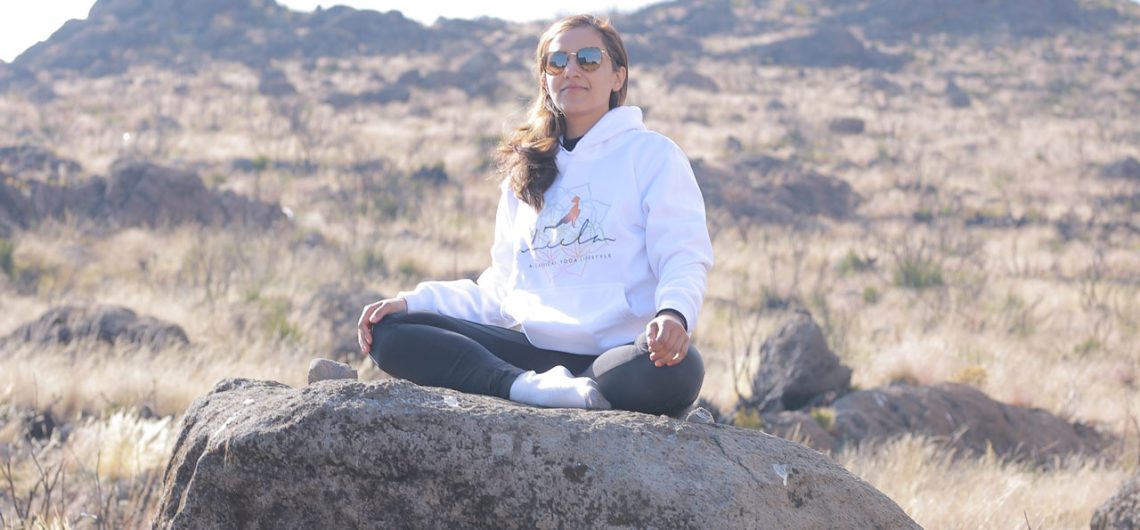
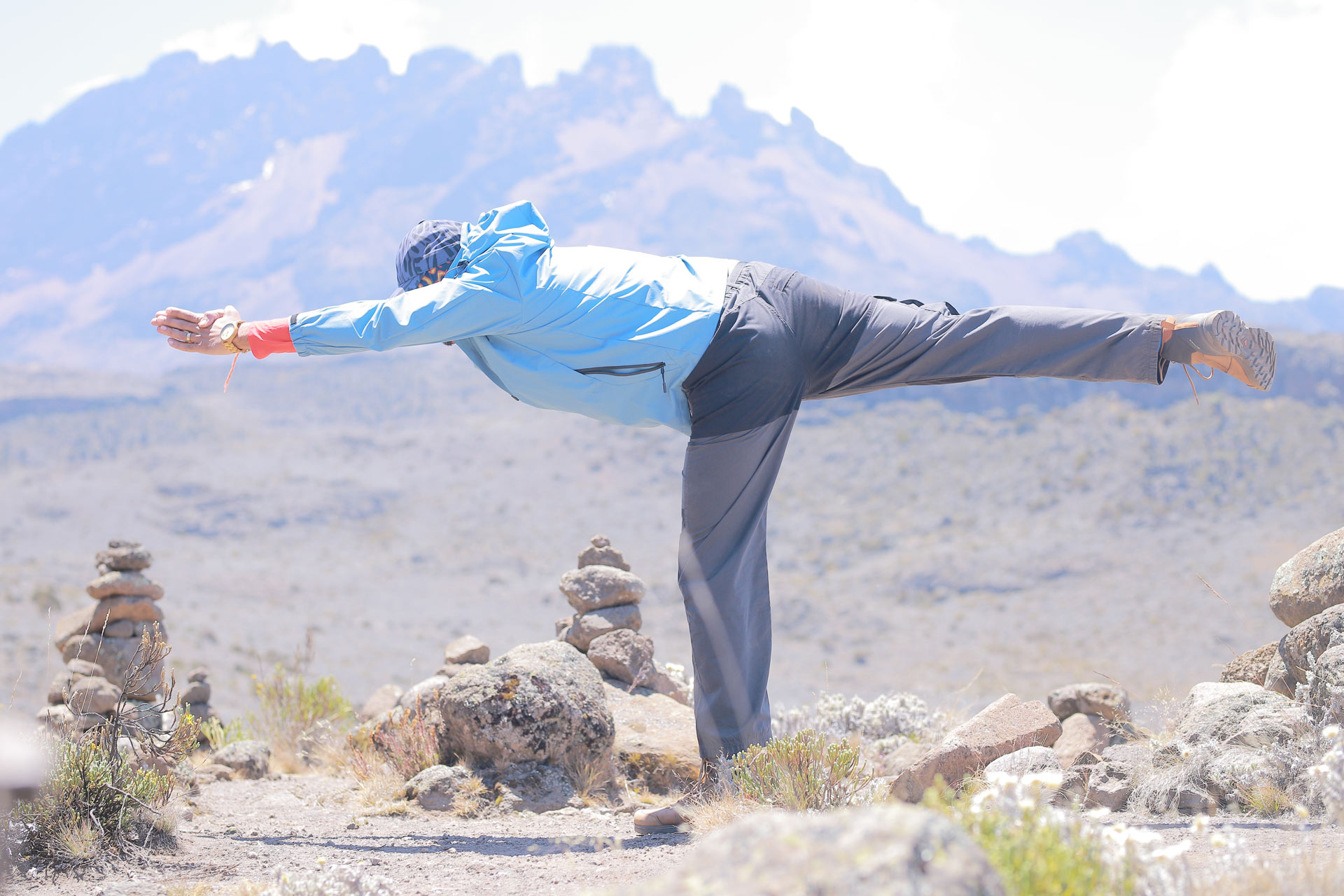 Physical preparation
Physical preparation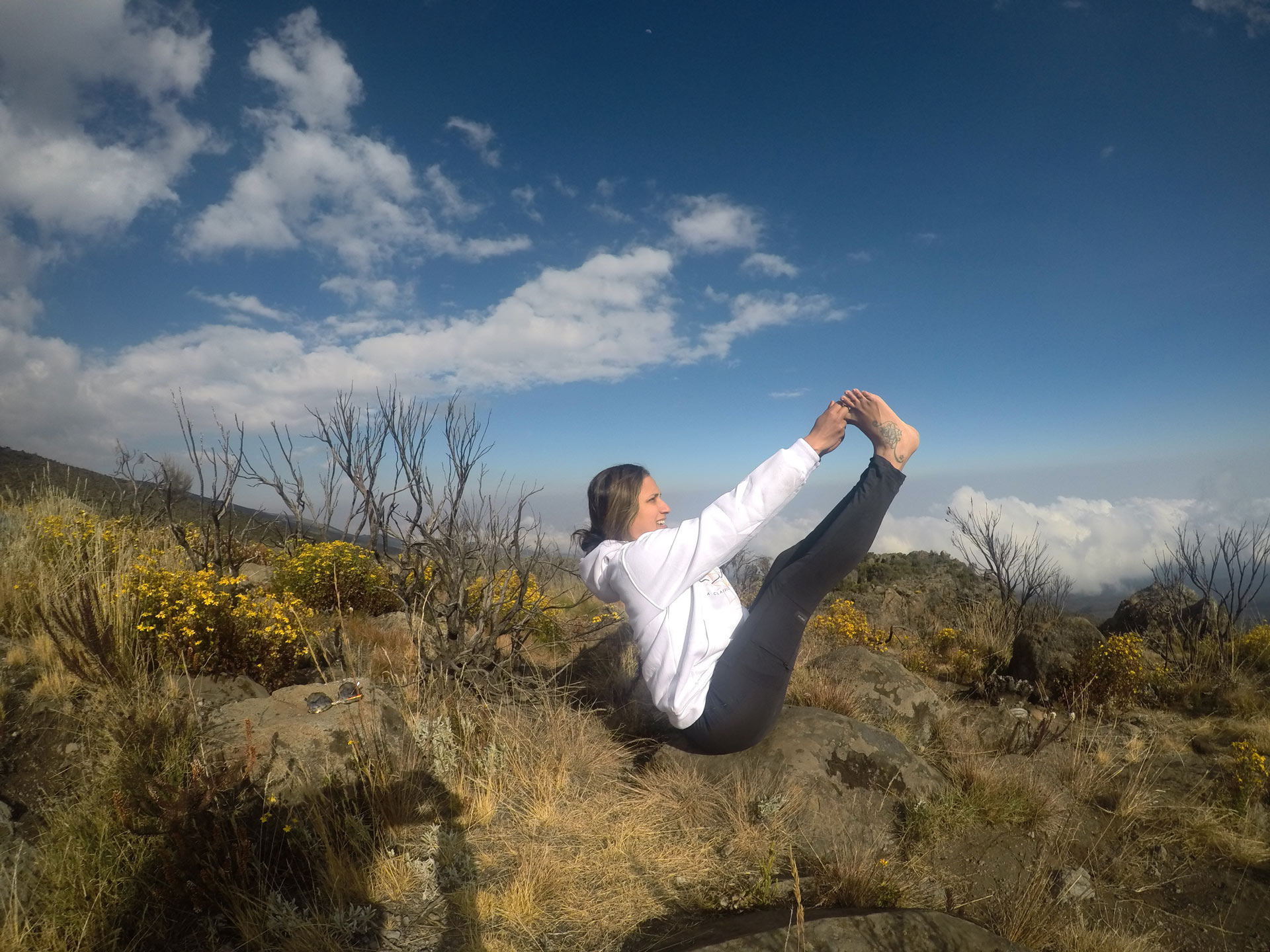 Mental preparation
Mental preparation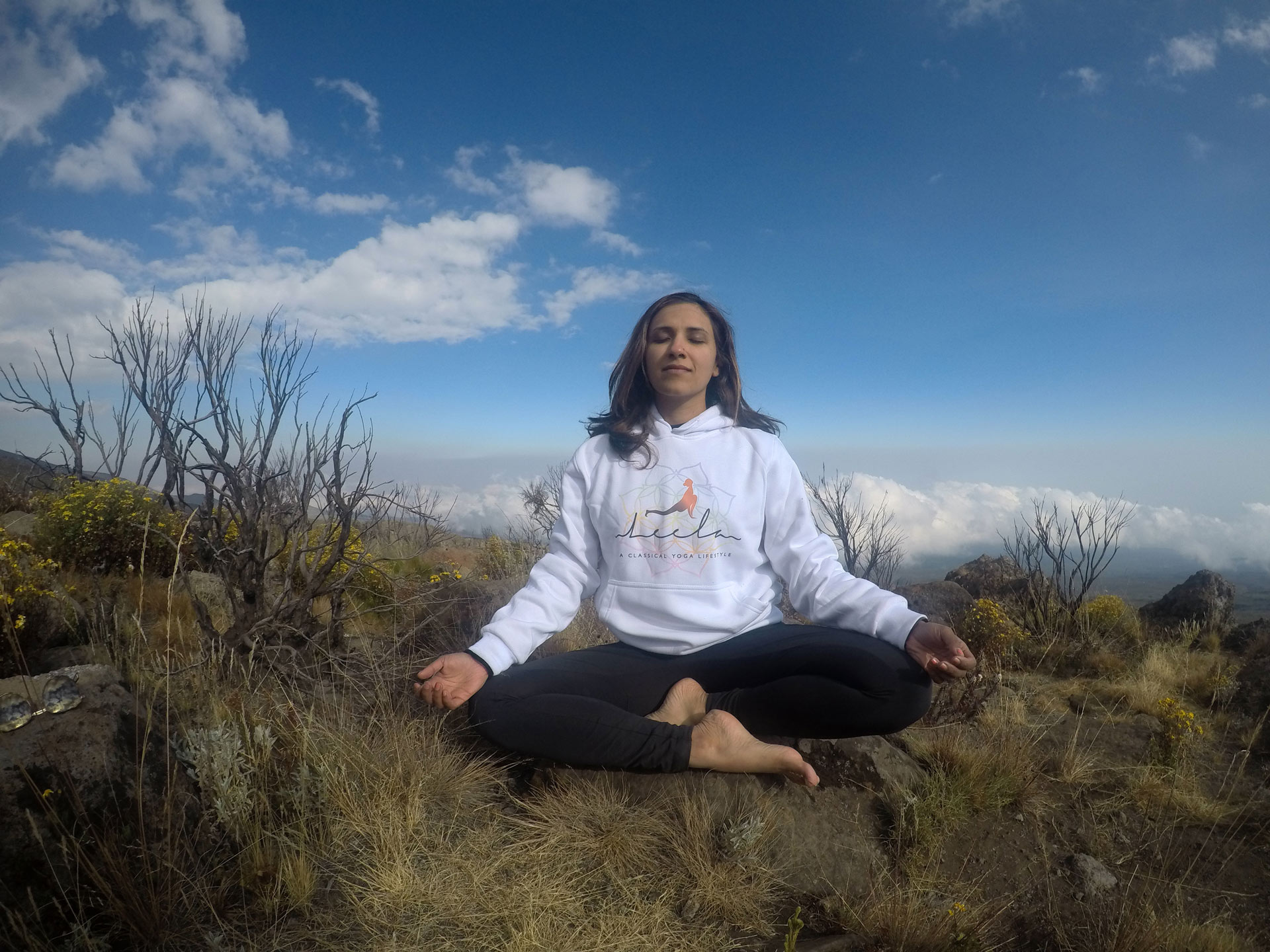 Yoga Practices on Mount Kilimanjaro
Yoga Practices on Mount Kilimanjaro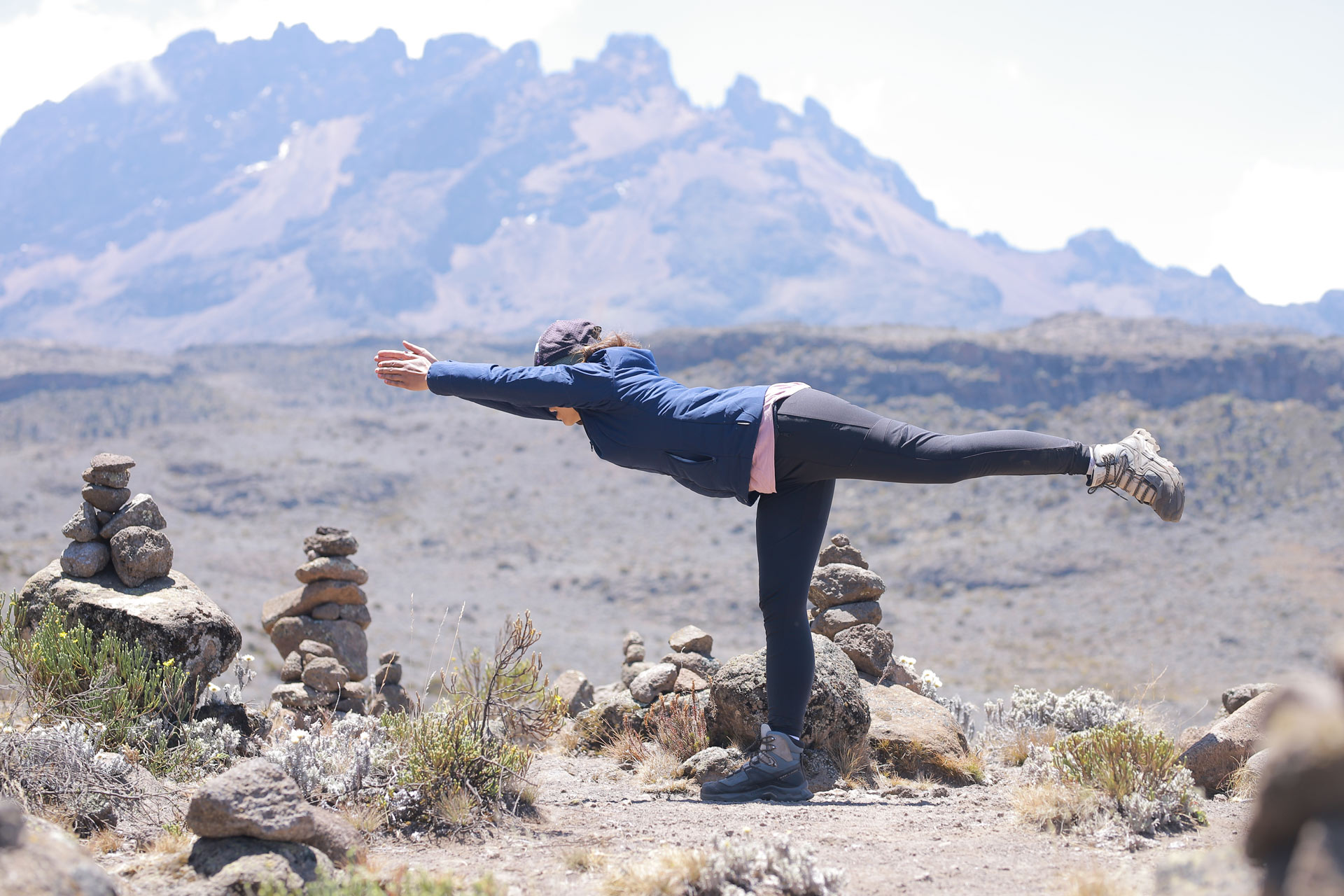 Breathing exercises
Breathing exercises